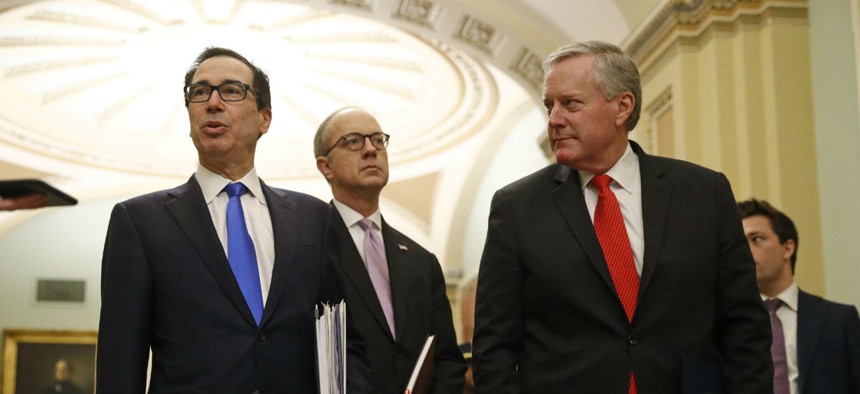
Treasury Secretary Steven Mnuchin, left, accompanied by White House Legislative Affairs Director Eric Ueland and acting White House chief of staff Mark Meadows meet with lawmakers Tuesday to discuss an economic stimulus package in response to coronavirus. Patrick Semansky/AP
COVID-19 Stimulus Must Include Oversight to Block Fraud
Fraudsters are waiting in the wings.
As Congress readies the largest economic stimulus bill in American history to help stem the fallout from the COVID-19 crisis, fraudsters are waiting in the wings. Fraud flourishes when oversight is lacking or nonexistent. And when the federal government’s goal is to get as much money as possible into the hands of people who need it, as quickly as possible, oversight is usually an afterthought. The final bill is still being worked out, but the size of the stimulus—close to or exceeding $2 trillion—and the speed with which the money will be made available, should make oversight paramount.
The risk here is real. With fast-moving economic stimulus, there are requests for accelerated payments, obligations and contract awards, which is a recipe for decreased oversight. Scammers preying on individuals with fake offers of stimulus grants will be prolific, which will require public service campaigns and other strategic communications efforts. Nearly every dollar spent will come with the potential for fraud or abuse.
Lessons abound from the past about the need for oversight in large federal aid programs. After Hurricane Katrina, the Bush administration hastily put together an aid package that the Federal Emergency Management Agency was poorly equipped to properly oversee. According to the Government Accountability Office, during the first six months following Hurricane Katrina, FEMA provided between $600 million and $1.4 billion in improper and potentially fraudulent financial assistance. Fraudsters had a veritable field day with the abundance of available money and lack of oversight.
The scrutiny FEMA faced following Katrina brought about some welcome changes to the agency’s approach to fraud mitigation after Hurricane Sandy. While up to 22% of Katrina assistance was found to be at risk of being improper or fraudulent, only about 3% of financial awards for Hurricane Sandy victims presented that risk, a result of additional oversight.
The American Recovery and Reinvestment Act, known as the Recovery Act, which injected nearly $800 billion in stimulus to help rebuild the economy following the 2008 mortgage crisis and ensuing recession, provides additional lessons. The Recovery Act created an accountability and transparency entity, the Recovery Board, that required any company or organization receiving contracts, grants or loans to file quarterly reports that were posted publicly on a government website, Recovery.gov. As GAO has reported, “The Recovery Act . . . paved the way for legislation that changed the standards for the transparency of government spending.”
The Recovery Board, disbanded in 2015, was hailed as a genuine success in managing the risk of fraud in Recovery Act funds. The Recovery Board oversaw nearly 3,200 audits, inspections, and other reviews by Inspectors General whose agencies received Recovery Act funding. Recovery Board-related probes by IGs resulted in 1,665 convictions, pleas and judgments, and more than $157 million in recoveries, forfeitures, seizures and estimated savings.
Recovery.gov became a model for accountability in government spending. It was the first governmentwide financial system to move to a cloud infrastructure. President Obama issued a 2011 executive order creating the Government Accountability and Transparency Board, now defunct, which was modeled on the Recovery Board, to manage oversight of all spending. Indeed, many have argued in the years since the Recovery Board was disbanded that the real benefit of the oversight mechanisms was the fraud that never happened because of enhanced scrutiny.
The complexity and size of the COVID-19 stimulus now being finalized requires a serious focus on government oversight. An oversight body like the Recovery Board is absolutely vital, as is a transparency mechanism similar to Recovery.gov. As with the Recovery Board, data analytics will be key.
Through innovative analytics software that structures data in search of patterns, the data analytics techniques used in Recovery.gov were refined to yield real results. For example, patterns in the data identified fraudulent Medicare providers operating out of empty buildings in Miami, business owners falsely claiming to be service-disabled veterans, and grant money recorded as being sent to an address that local citizens said was an empty shed. These are just a few among myriad examples.
The lessons of the past, if properly implemented, can result in providing needed economic relief to millions of Americans while safeguarding those funds from fraud. But the emphasis on oversight must be built in and implemented from day one. If Congress misses the opportunity to institutionalize oversight into COVID-19 stimulus, money will not only be wasted, but it may well miss its target.
Linda Miller is a Principal with Grant Thornton Public Sector, where she leads the fraud risk mitigation practice. She is a former senior official at GAO, where she led the development of GAO’s Fraud Risk Management Framework. Robert Shea, a Principal with Grant Thornton Public Sector, served as an Associate Director for Administration and Government Performance at the Office of Management and Budget.






